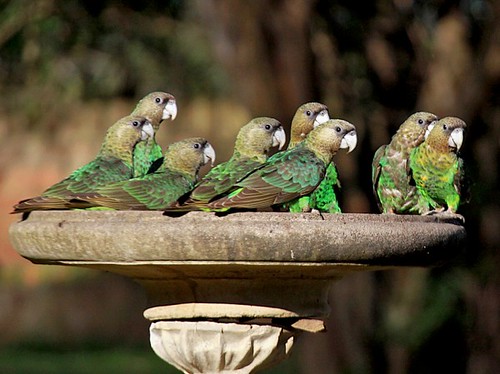 The Cape Parrot, with its characteristic loud squawk, relies mainly on yellowwood forest patches for food and shelter. It has a strong beak to crack open nuts and seeds. Almost all of the Cape parrots in King William's Town congregate every morning at this specific bird bath. Notice their poor condition due to the ravages of beak and feather disease and malnutrition. Image by Rodnick BiljonAfter huddling in the cold and mist during a two-day vigil, a band of dedicated bird-watching volunteers has tracked down almost 1 200 of SA’s rarest parrots.
The Cape Parrot, with its characteristic loud squawk, relies mainly on yellowwood forest patches for food and shelter. It has a strong beak to crack open nuts and seeds. Almost all of the Cape parrots in King William's Town congregate every morning at this specific bird bath. Notice their poor condition due to the ravages of beak and feather disease and malnutrition. Image by Rodnick BiljonAfter huddling in the cold and mist during a two-day vigil, a band of dedicated bird-watching volunteers has tracked down almost 1 200 of SA’s rarest parrots.
The Cape Parrot, the only parrot species found in SA and nowhere else, has been in steep decline since the 1940s, partly because of the caged bird trade, loss of living space and the spread of disease.
Professor Colleen Downs, of the University of KwaZulu-Natal, who also chairs the national Cape Parrot working group, estimates that there are about 1 600 of these endangered parrots left in the wild.
Now they have been mostly confined to a few areas in SA – the Balgowan and Karkloof area of KwaZulu-Natal, the Wild Coast and mistbelt forests around Hogsback in the Eastern Cape and Magoebaskloof in Limpopo.
Virtually the whole lifestyle |of these birds revolves around yellowwood trees, which provide food in the form of nuts and seeds, nesting cavities to rear their young and roosting spots.
They also feed from wild plums, white stinkwood and the dead flowerheads of some proteas.
Downs said that, to keep track of their numbers, a census had been held every year for the past 15 years.
The latest census, held over the weekend of May 5-6, involved deploying almost 250 volunteers to 72 observation posts in three provinces. After collating the results of the latest census, Downs concluded that there were still at least 1 189 of these birds living in the wild.
However, this figure was probably an underestimation of the population caused by the misty weather and poor visibility on the census weekend this year.
Downs said the annual census also helped to reveal information about other vulnerable species such as samango monkeys and Southern Ground Hornbills.
But, with the disappearance and decline of their main habitat, large groups of parrots sometimes left the forests to raid commercial plantations of pecan nuts or apple, pear or peach orchards – and several had been shot as crop pests.
Please join the Cape Parrot Project group on Facebook to stay up-to-date on our mission to help save this ambassador of South Africa’s previously impressive yellowwood forests.
PLEASE SUPPORT THE “LET’S HELP THE CAPE PARROT OF SOUTH AFRICA” CAUSE BY DONATING AND GETTING YOUR FRIENDS INVOLVED